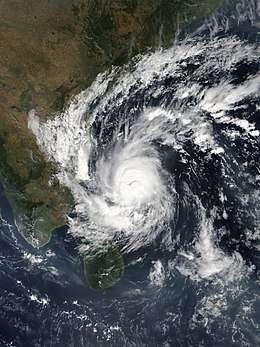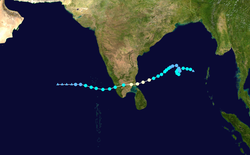Cyclone Gaja
Very Severe Cyclonic Storm Gaja was the sixth named cyclone of the 2018 North Indian Ocean cyclone season, after Cyclones Sagar, Mekunu, Daye, Luban, and Titli. Forming on November 5 as a low pressure system over the Gulf of Thailand, the system crossed through Southern Thailand and the Malay Peninsula and eventually crossed into the Andaman Sea. The weak system intensified into a depression over the Bay of Bengal on November 10 and further intensified to a cyclonic storm on November 11, being classified 'Gaja'. After tracking west-southwestward for a number of days in the Bay of Bengal, Gaja made landfall in South India, shifted through Vedaranyam, Voimedu, Thiruthuraipoondi, Muthupet, Pudukkottai, Adirampattinam, Pattukkottai and Peravurani. The storm survived its crossing into the Arabian Sea; however, it dissipated in hostile conditions only a few days later. 45 people were killed by the storm in that Thanjavur district pattukkotai alone 8 were killed. Gaja had severe impacts in South India, particularly in Tamil Nadu. After Cyclone Gaja, Tamil Nadu sought Rs 15,000 crore from Centre to rebuild. coconut trees of Pattukkottai and Peravurani.
| Very severe cyclonic storm (IMD scale) | |
|---|---|
| Category 1 tropical cyclone (SSHWS) | |
 Cyclone Gaja nearing South India on November 15 | |
| Formed | November 10, 2018 |
| Dissipated | November 19, 2018 |
| (Remnant low after November 20) | |
| Highest winds | 3-minute sustained: 130 km/h (80 mph) 1-minute sustained: 150 km/h (90 mph) |
| Lowest pressure | 976 hPa (mbar); 28.82 inHg |
| Fatalities | 45 total |
| Damage | $775 million (2018 USD) |
| Areas affected | Southern Vietnam, Malay Peninsula, Andaman Islands, Sri Lanka, Southern India (Tamil Nadu, Puducherry) |
| Part of the 2018 North Indian Ocean cyclone season | |
Meteorological history

On November 5, a low pressure system formed over the Gulf of Thailand. The system crossed through Southern Thailand and the Malay Peninsula on November 8. The next day, it crossed into the Andaman Sea and lingered there, organizing further throughout the day and intensified into a depression over the Bay of Bengal on November 10. The next day, the system was designated by the IMD as BOB 09. Soon after, the Joint Typhoon Warning Center (JTWC) issued a Tropical Cyclone Formation Alert (TCFA).
At 00:00 UTC on November 11, the deep depression strengthened into a cyclonic storm, and was given the name Gaja by the IMD. After tracking west-southwestward for a number of days, it made landfall near Nagapattinam in southern India, early on November 16 as a Very severe cyclonic storm. Afterward, Gaja passed through Vedaranyam, Voimedu, Muthupet, Pattukotai, Adirampattinam, and Mallipattinam, on the same day. The storm survived crossing over into the Arabian Sea later that day and continued moving westward; however, it degenerated into a remnant low in hostile conditions only several days later, on November 20. Late on the next day, the storm's remnants dissipated near Socotra.
Preparation, impacts and aftermath
Due to the possibility of adverse effects in the coastal regions of Tamil Nadu and Puducherry, early steps were taken by the state governments. About 80,000 were evacuated to 470 relief camps from the districts which were vulnerable to the cyclone in Tamil Nadu.[1] Holidays were also announced in the coastal districts of the Cauvery delta region in Tamil Nadu as well as Puducherry.[2] People were advised not to come out of the house, as the cyclone caused high winds. Preventative measures were explained through all media.[3]
At the time of landfall of the cyclone, heavy winds of about 175–180 km/h speed were experienced. The highest wind gust was recorded in Adhirampattinam at 181 km/h, and Muthupet recorded a wind gust of 180 km/h. Regions of Karaikal and Nagapattinam also experienced 100 km/h winds. The affected areas were the districts of Nagappattinam, Thanjavur, Thiruvarur, Pudukottai, Karaikal, Trichy and Ramanathapuram. About 100,000 electric poles, 1,000 transformers, 201 electricity substations and 5,000 boats were destroyed by the cyclone.[4] Thousands of cattle and birds died due to the cyclone. 45 people died, mostly in the districts of Thiruvarur, Thanjavur, and Pudukottai. About 18,000 hectares of Coconut trees were damaged, mostly uprooted. Totally 56,000 hectares of crops and trees were destroyed due to the cyclone.[5]
See also
References
- "Gaja wreaks havoc in T.N." The Hindu. Special Correspondent. 2018-11-17. ISSN 0971-751X. Retrieved 2018-12-05.CS1 maint: others (link)
- "Cyclone Gaja likely to hit TN on Thursday evening; holiday declared for schools in some districts and 16 trains cancelled - Times of India". The Times of India. Retrieved 2018-12-05.
- DelhiNovember 16, IndiaToday in New; November 16, 2018UPDATED; Ist, 2018 18:07. "Cyclone Gaja: TN government braces up itself for the calamity". India Today. Retrieved 2018-12-05.CS1 maint: numeric names: authors list (link)
- https://www.thenewsminute.com/article/donations-pour-tn-aftermath-cyclone-gaja-91964
- Kumar, L. N. Revathy & V. Sajeev. "When perennial crops fall prey to nature's fury..." @businessline. Retrieved 2018-12-05.
External links
- second strongest cyclone since 1996' – The New Indian Express
